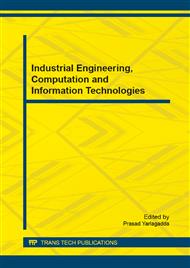[1]
C. Perera; A. Zaslavsky; P. Christen; D. Georgakopoulos, Context Aware Computing for the Internet of Things: A Survey, IEEE Communications Surveys & Tutorials, vol. 16, no. 1, (2014).
DOI: 10.1109/surv.2013.042313.00197
Google Scholar
[2]
Jiong Jin; J. Gubbi; S. Marusic; M. Palaniswami, An Information Framework for Creating a Smart City Through Internet of Things, Internet of Things Journal, IEEE, vol. 1, no. 2, pp.112-121, (2014).
DOI: 10.1109/jiot.2013.2296516
Google Scholar
[3]
Shancang Li; G. Oikonomou; T. Tryfonas; T.M. Chen; Li Da Xu, A Distributed Consensus Algorithm for Decision Making in Service-Oriented Internet of Things, IEEE Transactions on Industrial Informatics, vol. 10, no. 2, pp.1461-1468, (2014).
DOI: 10.1109/tii.2014.2306331
Google Scholar
[4]
Shi-Wei Jiang; Wei-Min Lv; Jia-Chen Feng, Research on process modeling and analyzing methods of distributed equipment system-of-systems, 2012 International Conference on Quality, Reliability, Risk, Maintenance, and Safety Engineering (ICQR2MSE), (2012).
DOI: 10.1109/icqr2mse.2012.6246210
Google Scholar
[5]
R. Fernandez; J. Riddlebaugh; J. Brinkman; M. Wilkinson, Spaceflight ground support equipment reliability & system safety data, 2012 Proceedings - Annual Reliability and Maintainability Symposium (RAMS), pp.1-5, (2012).
DOI: 10.1109/rams.2012.6175498
Google Scholar
[6]
Xinping Yan; Yuelei Zhang; Chenxing Sheng; Chengqing Yuan, Study on remote fault diagnosis system using multi monitoring methods on dredger, 2010 Prognostics and Health Management Conference (PHM'10), pp.1-4, (2010).
DOI: 10.1109/phm.2010.5413406
Google Scholar
[7]
Yanqiang Li; Zhigang Yao; Jiadian Huang; Yan Zhang, Study on ship equipments reliability centered maintenance analysis method, 2011 International Conference on Quality, Reliability, Risk, Maintenance, and Safety Engineering (ICQR2MSE), pp.699-701(2011).
DOI: 10.1109/icqr2mse.2011.5976706
Google Scholar
[8]
Xiaoying Zhang; Hong Chen; Ke Wang; Hui Peng; Yongjian Fan; Deying Li, Rotation-based privacy-preserving data aggregation in wireless sensor networks, 2014 IEEE International Conference on Communications (ICC), pp.4184-4189, (2014).
DOI: 10.1109/icc.2014.6883977
Google Scholar
[9]
I. Stojmenovic, Machine-to-Machine Communications With In-Network Data Aggregation, Processing, and Actuation for Large-Scale Cyber-Physical Systems, Internet of Things Journal, IEEE, vol. 1, no. 2, pp.122-128, (2014).
DOI: 10.1109/jiot.2014.2311693
Google Scholar


